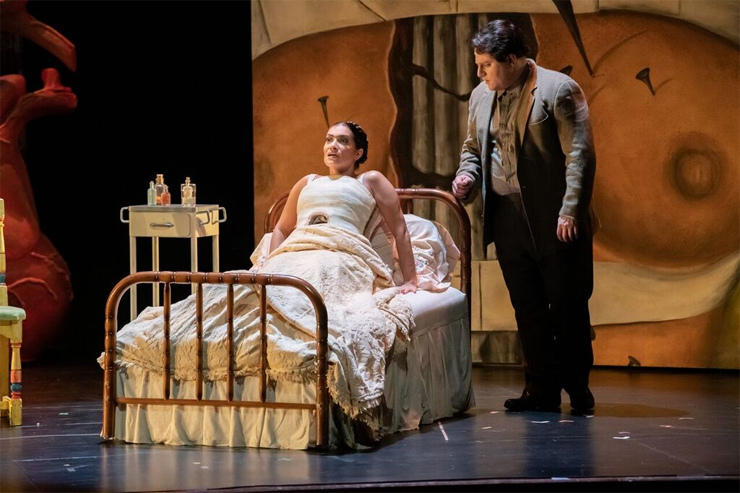
Photo credit: Chris Kakol
In keeping with Florida Grand Opera General Director Susan T. Danis’s vision of mixing lessor known contemporary works with the traditional repertoire, on Saturday, March 16, FGO presented the South Florida premiere of Robert Xavier Rodríguez’s 1991 opera, “Frida,” based on the life of Mexican painter Frida Kahlo.
Granted, the historical Kahlo is easily obscured by the reality that her popularity only began to gain steam decades after her death. During her lifetime she was primarily known as the wife of the muralist Diego Rivera and an international eccentric personality. But the “wild, hybrid Frida, a mixture of tragic bohemian, revolutionary heroine and celebrated painter,” has become a commercial success and has gripped the imagination of a fan base that has reached almost religious proportions.
Three of her paintings recently fetched multi-million-dollar purses; she is now considered among the most important artists of the 20th century, and her life and art have inspired a variety of merchandise, including a Barbie "shero." Her distinctive style has been appropriated by the fashion world, she is the first Hispanic woman to be honored with a U.S. postage stamp, has been featured in an Oscar winning Hollywood biopic (“Frida”), was cameoed in the Disney-Pixar animated film “Coco” and has been the subject of novels, documentaries, and yes, opera.
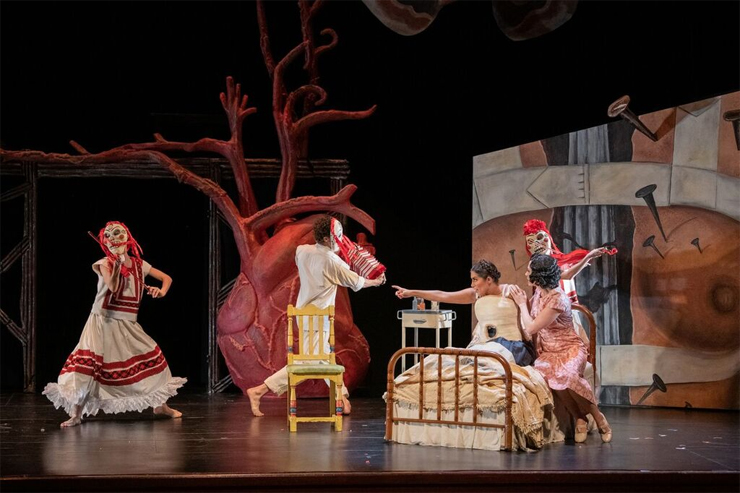
Photo credit: Chris Kakol
While Rodríguez’s R-rated opera might be considered deficient of the conventional aspects of operatic sensibilities, lacking big arias and a lush score, it is nevertheless a cohesive work, as difficult as it is to squeeze Kahlo’s whole story in a compact 2 hours and 30 minutes.
Regarded simultaneously as both a victim, crippled by accident and disease, and as a survivor who fought back, Kahlo was a complex figure whose fierce independent spirit, political bent and sexual ambiguity begs the question:Was the art overshadowed by the artist? Was it her life or her art that has captured the collective imagination of the world? Of course, it is both.
Perhaps more a musical theater piece with operatic tendencies, including dialogue spoken and sung in both English and Spanish, the conveyance chosen by Rodríguez to tell Kahlo’s complex story was a string of thirteen scenes flowing together seamlessly, fleshing out the major episodes in Kahlo’s life from her early years as a revolutionary, to the horrific bus accident that fractured her spine leaving her permanently physically disabled, to her torrid marriage to Diego Rivera and her sexual relationships with multiple partners, to her inimitable career as a celebrated painter. This is truly theater of the self.
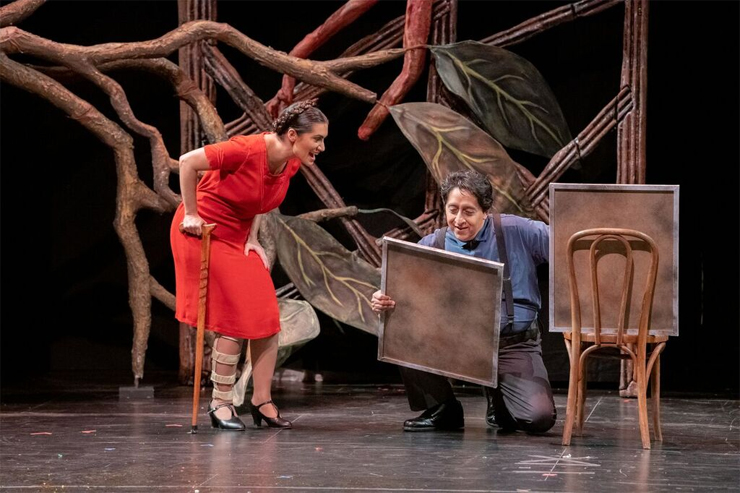
Photo credit: Chris Kakol
Playing Kahlo, soprano Catalina Cuervo was a force of nature, vocally portraying the extant power inside the woman with volume that easily filled the hall, fleshing out her vulnerable side with lyric subtlety. Her acting chops, however, were at times over-wrought, especially when she used an exaggerated speaking voice in her dialogue scenes. Whether that melodramatic choice was hers or that of director Marco Pelle, it proved to be distracting. She was more believable and interesting when delivering several monologues.
Bass-baritone Ricardo Herrera, playing Diego Rivera, was well-drawn,a fully realized character, whose voice was rich and round, appropriately booming when emotional, and quietly lyric when sincere.
Cuervo, petite, and the much larger Herrera, were the embodiment of what Kahlo’s parents referred to as a "marriage between an elephant and a dove." Proportional differences aside, in their scenes together, Cuervo and Herrera generated volatile chemistry, sometimes very blatantly seductive (their first wedding), sometimes intensely combative (the fight over their respective lovers), sometimes playful (their second wedding).
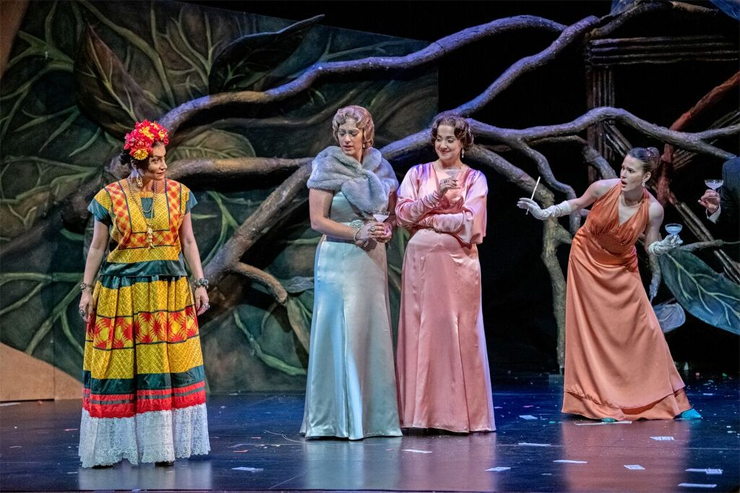
Photo credit: Chris Kakol
Maestro Roberto Kalb robustly conducted Rodríguez’s idiosyncratic score,navigating his sturdy players through the mariachi-style orchestration, with accordion, marimba, guitar, violin, piano and trumpet rendering the authentic and imagined Mexican folk songs and dances, tangos and romantic melodies, accented with colors of zarzuela, ragtime, vaudeville and 1930s jazz figures. The overture tinged with marimba turned dissonant, flavored with mariachi sentiment, and the story was afoot.
Cuervo’s voice was broad, pure and honest, clarion and subtle, as she endured the bus crash, rising above the broken bones and a pierced abdomen,fiercely determined to press on – an accordion grounding the scene.
In a monologue comparing styles – “Diego paints the big outside. I paint the secrets inside.” – Frida clarified that she fights for “love, sex, cigarettes…and tequila.” After a miscarriage, she pleaded with Diego to return to Mexico; Cuervo, strong and genuine, duetted with Herrera, their low and high voices matching and blending winsomely.
After returning home to Mexico from New York, in a break-away aria, Cuervo ruminated on how “life is much too short,” pulling out heartfelt grief as Frida dealt with Diego’s affair with her sister, a solo violin tastefully complimenting her honest emotion.
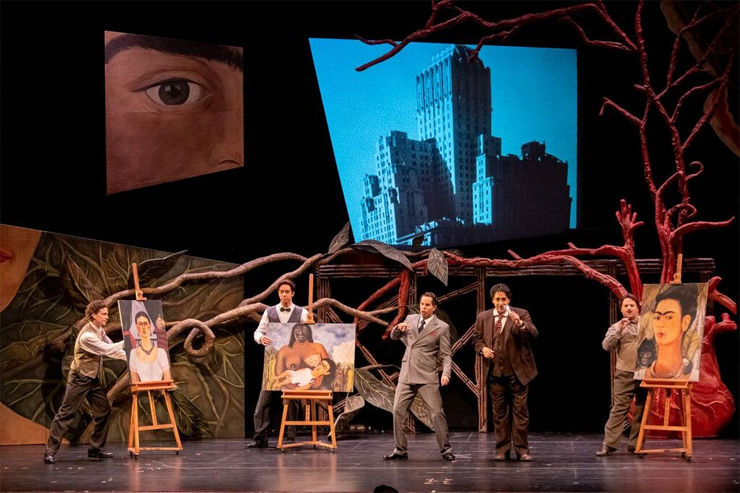
Photo credit: Chris Kakol
In another monologue, Frida expressed, “I paint, and I paint,” perhaps as therapy for her deteriorating condition, the music underscoring her pain and her passion as she painted her self-portraits and folk-art images. A solo violin suggested tenderness, Frida’s imagined paintings coming to life in her mind – “The Broken Column” (where her broken spine is replaced by a crumbling column), “The Wounded Deer” and “Self Portrait with Monkeys” – Cuervo insisting, “Don’t forget me, damnit!” earnestly singing the lush refrain.
Herrera’s stage presence was formidable, whether he was declaiming that a “revolutionary artist paints what he wants” or, wearing his tux, “It’s not every day I get to dress like a capitalist,” or, during the scene where he spurns his wife Lupe (Zaray Rodriguez) for Frida. His lyrical voice blended beautifully in his duets with Cuervo, as they married, and in their tortured exchange when he accused her for her affair with Trotsky, and in the high sparks confrontation when he asked for a divorce. Herrera also mixed nicely with Simon Dyer, playing Edward G. Robinson,though Dyer's speaking chops weren’t up to matching Robinson’s classic repartee.
The ensemble of school girls, Cachucha gang members, revolutionaries, passengers, wedding guests, communists, socialites, and female/male lovers, also sang and acted in a variety of guises, as celebs, masked beings and as two or three-dimensional puppets. Shadow puppets and projections were also involved.
The ensemble filled the acoustically desirable Miramar Cultural Center hall with spot-on harmonies, fugue-like in the opening scene peppered with bells, marimba and brass. The confrontational quintet between Cuervo, Herrera, Dominick Corbacio (Leon Trotsky), Mariya Kaganskaya (Natalia Trotsky) and soprano Jessica E. Jones as Cristina Kahlo, was a richly layered aural feast. Likewise, the scene with Rockefeller (Benjamin Dickerson) accusing Rivera of portraying Vladimir Lenin in his commissioned mural, brought vocally elevated emotion.
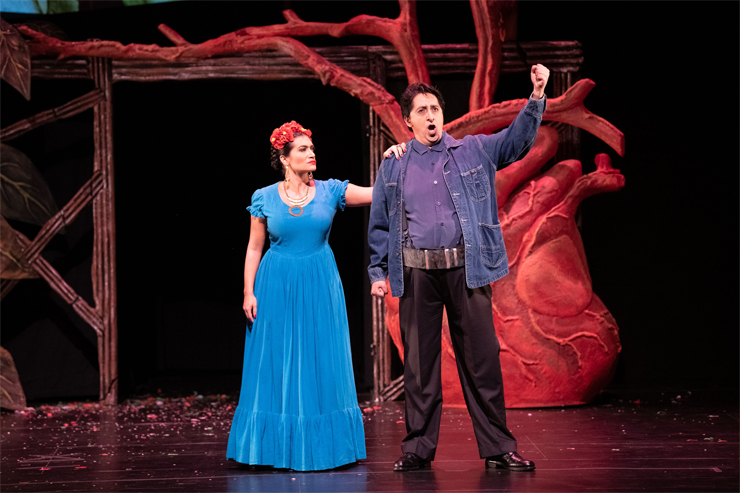
Photo credit: Chris Kakol
In the final scene, Frida fighting to live (“Yesterday I was fighting for my freedom. Today I’m fighting for my life.”), Cuervo, with a round and powerful voice, made her case convincingly – “Viva la Vida, alegría…” – the chorus joining in a big percussive finish, “From birth to death, Frida’s colors will live forever!”
Whether Rodríguez’s opera mined deep enough to substantially flesh out Kahlo’s pain, her political activism, or her profoundly unusual lifestyle and marriage to Rivera, reverence to her art was well presented.
Kahlo's oeuvre was on full display as part of Moníka Essen’s set – panels displayed self-portraits, her chin and lips, a single eye, a naked breast, “Diego and I,” still life of fruit and flowers, and a vertical sculpture of a human heart branching up into veins. A raised wooden platform included a panel onto which were projections that transported us to different locales, including Rivera’s mural at Rockefeller Center and historical footage of New York.
Essen’s costumes included traditional Mexican garb accentuated with red and black accents, complementing the long exaggerated slinky movements of the dancers celebrating Día de Muertos. Frida’s bright yellow peasant dress with multi-colored embroidered designs went well with her dark hair, which was usually in tight braids and adorned with crowns of colorful flowers. The socialites wore full length ball gowns in pastel colors.
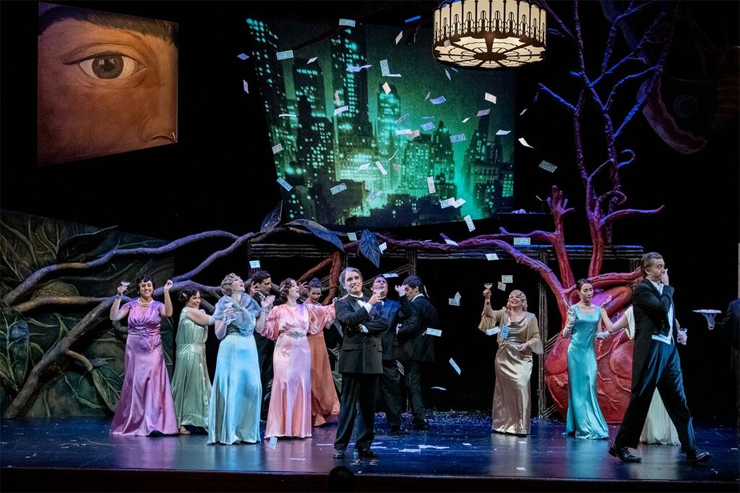
Photo credit: Chris Kakol
Frida By Robert Xavier Rodríguez; book by Hilary Blecher; lyrics and monologues by Migdalia Cruz; conductor, Roberto Kalb; directed and choreographed by Marco Pelle; production, Jose Maria Condemi and Michigan Opera Theatre; sets and costumes by Moníka Essen; lighting by Nate Wheatley; wig and make-up by Sue Schaefer; assistant conductor, Gordon Schermer; production stage manager, Megan Bennett; FGO general director, Susan T. Danis; projected English titles by Dee Dorsey; projected Spanish titles by Dreambay Enterprises; audio description by Sara Zajic
CAST: Frida Kahlo - Catalina Cuervo, Diego Rivera - Ricardo Herrera, Cristina Kahlo - Jessica E. Jones, Mrs. Ford - Evan Kardon, Dimas' Mother/Lupe Marín - Zaray Rodriguez, Mrs. Rockefeller/Natalia Trotsky - Mariya Kaganskaya, Alejandro/Leon Trotsky - Dominick Corbacio, Mr. Ford - Dylan Morrongiello, Petate Vendor/Mr. Kahlo/Mr. Rockefeller - Benjamin Dickerson, Barker - Sean Galligan, Calavera/Edward G. Robinson - Simon Dyer, Calavera - Laura Leon, Calavera - Stephany Peña
Remaining schedule | "Frida" sung in English and Spanish with projected titles in English and Spanish.
Miami-Dade County Auditorium
- Thursday, March 21, at 8 p.m.
- Saturday, March 23, at 7 p.m.
- Sunday, March 24, at 3 p.m.
Parker Playhouse
- Thursday, March 28, at 7:30 p.m.
- Saturday, March 30, at 7:30 p.m.
Audio Description is available without charge for blind and visually impaired patrons attending FGO operas.
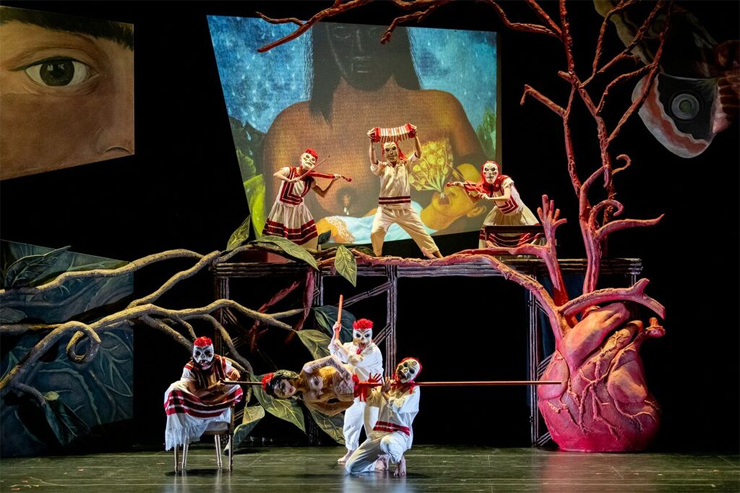
Photo credit: Chris Kakol
Tickets start at $35 and can be purchased in person at the Florida Grand Opera Box Office at the Doral Center at 8390 NW 25th Street, Miami, FL 33122, online at www.FGO.org, by phone at 1.800.741.1010, or email at Sales@FGO.org. Tickets can also be purchased through the venue box offices onsite and online at the Miami-Dade County Auditorium at www.MiamiDadeCountyAuditorium.org, Parker Playhouse at www.ParkerPlayhouse.com, and on www.Ticketmaster.com.
 MAIN MENU
MAIN MENU

